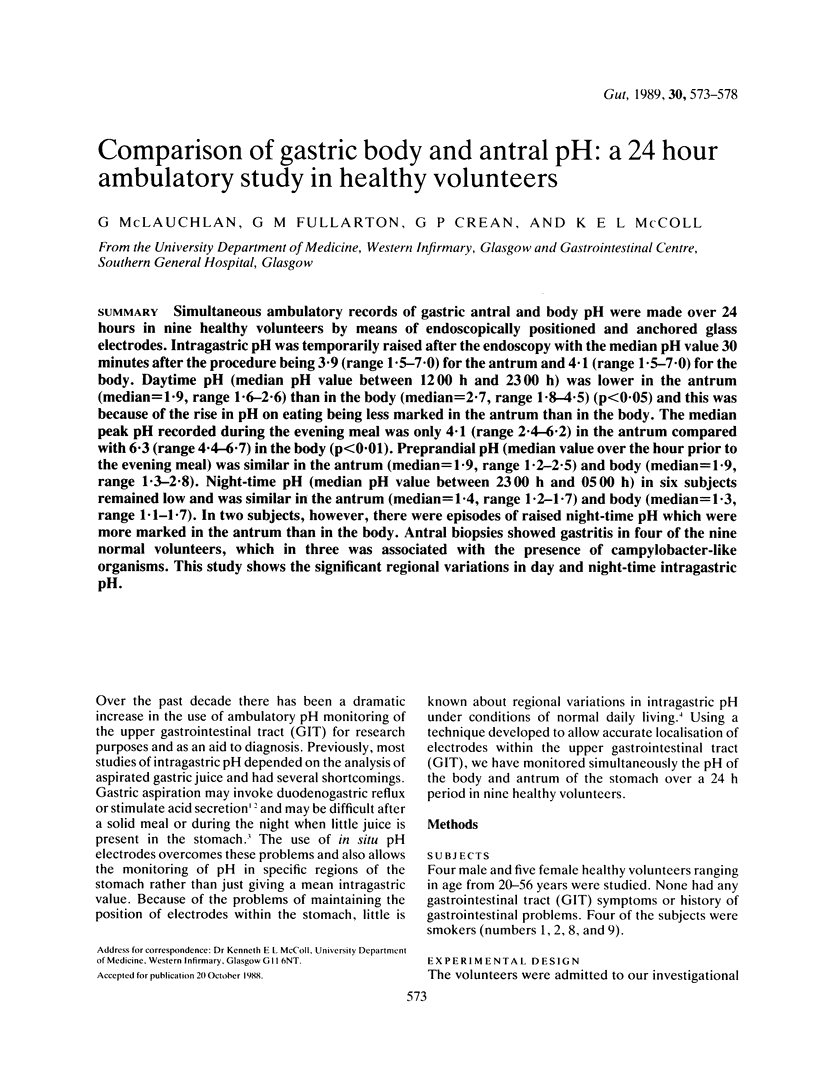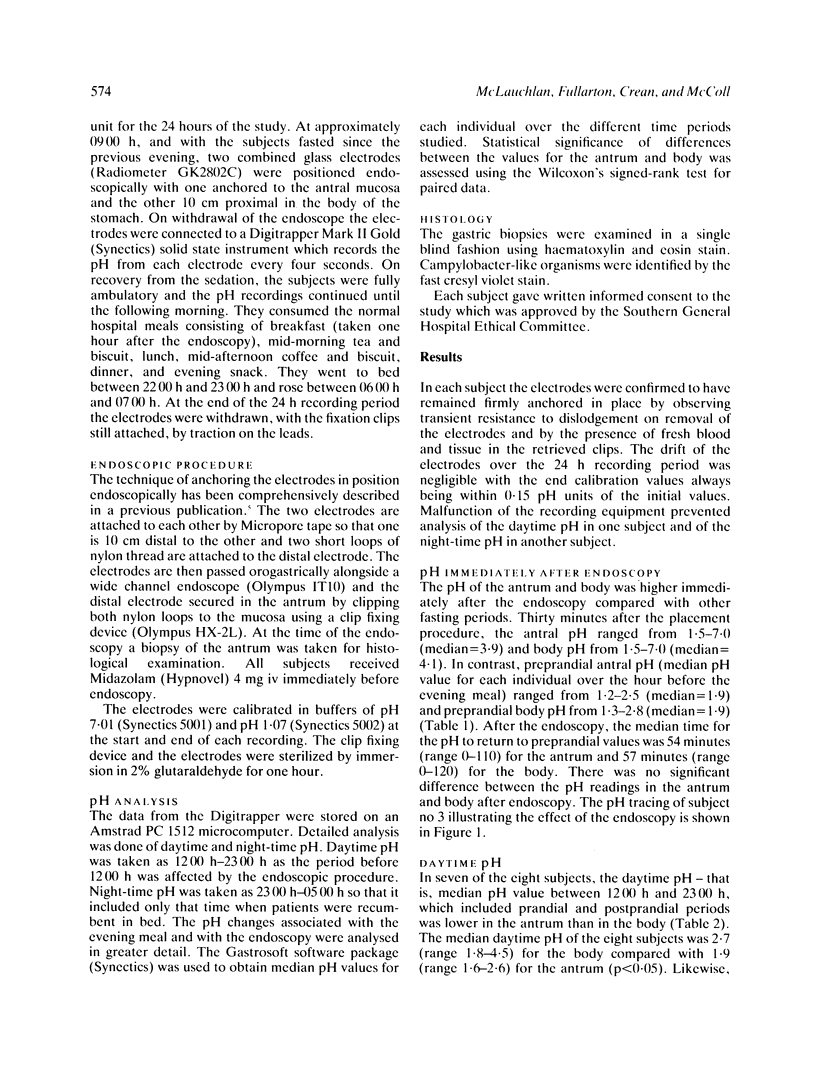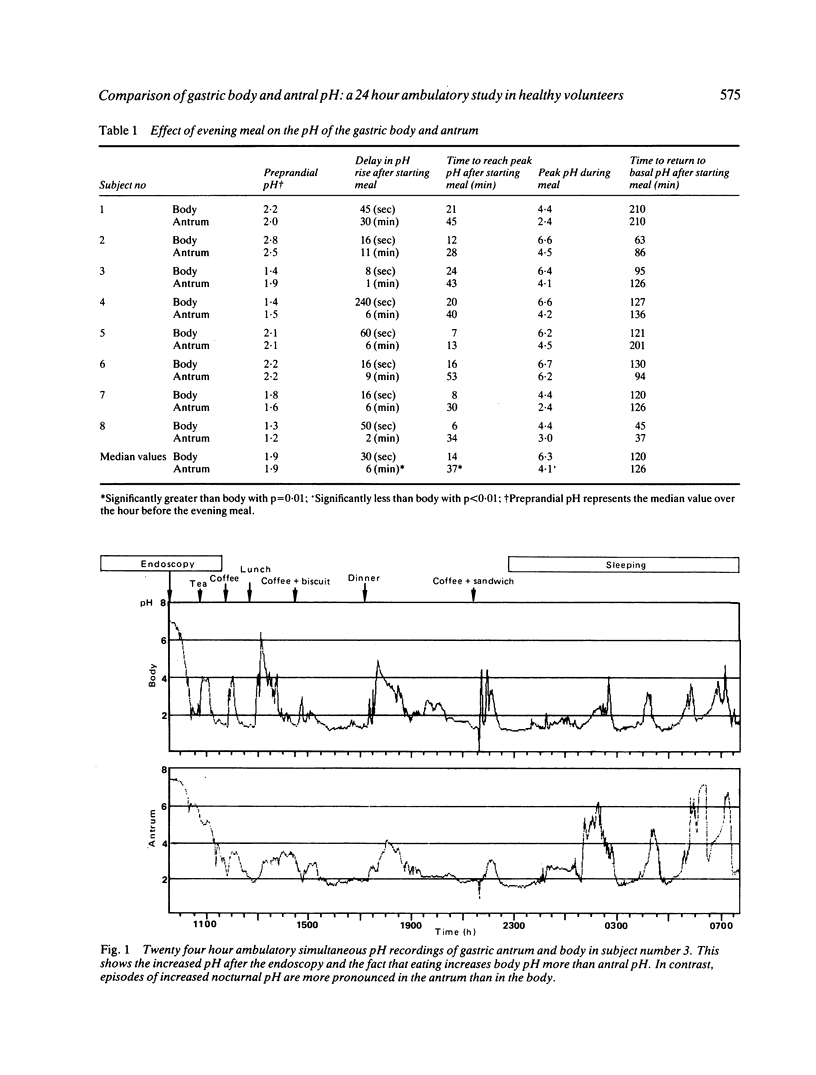Abstract
Simultaneous ambulatory records of gastric antral and body pH were made over 24 hours in nine healthy volunteers by means of endoscopically positioned and anchored glass electrodes. Intragastric pH was temporarily raised after the endoscopy with the median pH value 30 minutes after the procedure being 3.9 (range 1.5-7.0) for the antrum and 4.1 (range 1.5-7.0) for the body. Daytime pH (median pH value between 12 00 h and 23 00 h) was lower in the antrum (median = 1.9, range 1.6-2.6) than in the body (median = 2.7, range 1.8-4.5) (p less than 0.05) and this was because of the rise in pH on eating being less marked in the antrum than in the body. The median peak pH recorded during the evening meal was only 4.1 (range 2.4-6.2) in the antrum compared with 6.3 (range 4.4-6.7) in the body (p less than 0.01). Preprandial pH (median value over the hour prior to the evening meal) was similar in the antrum (median = 1.9, range 1.2-2.5) and body (median = 1.9, range 1.3-2.8). Night-time pH (median pH value between 23 00 h and 05 00 h) in six subjects remained low and was similar in the antrum (median = 1.4, range 1.2-1.7) and body (median = 1.3, range 1.1-1.7). In two subjects, however, there were episodes of raised night-time pH which were more marked in the antrum than in the body. Antral biopsies showed gastritis in four of the nine normal volunteers, which in three was associated with the presence of campylobacter-like organisms. This study shows the significant regional variations in day and night-time intragastric pH.
Full text
PDF





Selected References
These references are in PubMed. This may not be the complete list of references from this article.
- Bauerfeind P., Cilluffo T., Fimmel C. J., Gasser T., Köhler W., Merki H., Emde C., Etienne A., Blum A. L. Die intragastrale Langzeit-pH-Metrie. Schweiz Med Wochenschr. 1985 Nov 16;115(46):1630–1641. [PubMed] [Google Scholar]
- Emde C., Garner A., Blum A. L. Technical aspects of intraluminal pH-metry in man: current status and recommendations. Gut. 1987 Sep;28(9):1177–1188. doi: 10.1136/gut.28.9.1177. [DOI] [PMC free article] [PubMed] [Google Scholar]
- Fimmel C. J., Etienne A., Cilluffo T., von Ritter C., Gasser T., Rey J. P., Caradonna-Moscatelli P., Sabbatini F., Pace F., Bühler H. W. Long-term ambulatory gastric pH monitoring: validation of a new method and effect of H2-antagonists. Gastroenterology. 1985 Jun;88(6):1842–1851. doi: 10.1016/0016-5085(85)90009-5. [DOI] [PubMed] [Google Scholar]
- Fordtran J. S., Walsh J. H. Gastric acid secretion rate and buffer content of the stomach after eating. Results in normal subjects and in patients with duodenal ulcer. J Clin Invest. 1973 Mar;52(3):645–657. doi: 10.1172/JCI107226. [DOI] [PMC free article] [PubMed] [Google Scholar]
- Heading R. C. Duodenogastric reflux. Gut. 1983 Jun;24(6):507–509. doi: 10.1136/gut.24.6.507. [DOI] [PMC free article] [PubMed] [Google Scholar]
- Hostein J., Bost R., Faure H., Lachet B., Fournet J. Valeur diagnostique de la pHmétrie gastrique au cours du reflux duodéno-gastrique. Gastroenterol Clin Biol. 1987 Mar;11(3):206–211. [PubMed] [Google Scholar]
- Jones D. M., Eldridge J., Fox A. J., Sethi P., Whorwell P. J. Antibody to the gastric campylobacter-like organism ("Campylobacter pyloridis")--clinical correlations and distribution in the normal population. J Med Microbiol. 1986 Aug;22(1):57–62. doi: 10.1099/00222615-22-1-57. [DOI] [PubMed] [Google Scholar]
- Jones D. M., Lessells A. M., Eldridge J. Campylobacter like organisms on the gastric mucosa: culture, histological, and serological studies. J Clin Pathol. 1984 Sep;37(9):1002–1006. doi: 10.1136/jcp.37.9.1002. [DOI] [PMC free article] [PubMed] [Google Scholar]
- Keane F. B., Dimagno E. P., Malagelada J. R. Duodenogastric reflux in humans: its relationship to fasting antroduodenal motility and gastric, pancreatic, and biliary secretion. Gastroenterology. 1981 Oct;81(4):726–731. [PubMed] [Google Scholar]
- McLauchlan G., Buchanan N. M., Crean G. P., McColl K. E. An endoscopic procedure for accurate localisation of intraluminal pH electrodes. Endoscopy. 1987 May;19(3):124–126. doi: 10.1055/s-2007-1018256. [DOI] [PubMed] [Google Scholar]
- Müller-Lissner S. A., Fimmel C. J., Sonnenberg A., Will N., Müller-Duysing W., Heinzel F., Müller R., Blum A. L. Novel approach to quantify duodenogastric reflux in healthy volunteers and in patients with type I gastric ulcer. Gut. 1983 Jun;24(6):510–518. doi: 10.1136/gut.24.6.510. [DOI] [PMC free article] [PubMed] [Google Scholar]
- Niemelä S., Karttunen T., Heikkilä J., Lehtola J. Characteristics of reflux gastritis. Scand J Gastroenterol. 1987 Apr;22(3):349–354. doi: 10.3109/00365528709078603. [DOI] [PubMed] [Google Scholar]
- O'Connor H. J., Wyatt J. I., Dixon M. F., Axon A. T. Campylobacter like organisms and reflux gastritis. J Clin Pathol. 1986 May;39(5):531–534. doi: 10.1136/jcp.39.5.531. [DOI] [PMC free article] [PubMed] [Google Scholar]
- Ritchie W. P. Alkaline reflux gastritis: a critical reappraisal. Gut. 1984 Sep;25(9):975–987. doi: 10.1136/gut.25.9.975. [DOI] [PMC free article] [PubMed] [Google Scholar]
- Robinson P. H., Clarke M., Barrett J. Determinants of delayed gastric emptying in anorexia nervosa and bulimia nervosa. Gut. 1988 Apr;29(4):458–464. doi: 10.1136/gut.29.4.458. [DOI] [PMC free article] [PubMed] [Google Scholar]


